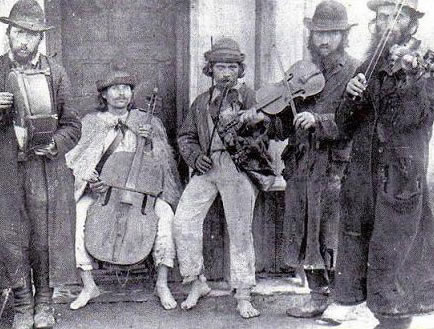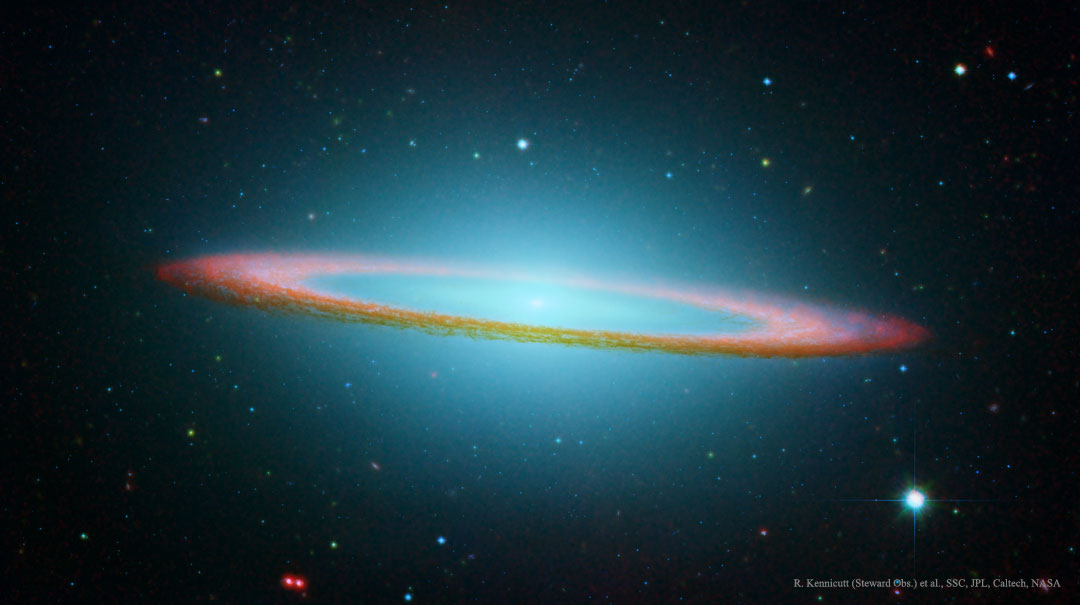Blog
The truly massive galaxy cluster 2MASX J05101744-4519179 basks in the centre of this image from the NASA/ESA Hubble Space Telescope. This distant galaxy cluster is a cosmic leviathan that is highly luminous at X-ray wavelengths. Observing galaxy clusters like 2MASX J05101744-4519179 can advance our understanding of the evolution and interactions of dark and luminous matter in galaxy clusters, and also reveals powerful gravitational ‘telescopes’ that magnify distant objects through gravitational lensing. Knowing the location of these lenses can enable future observations with both Hubble and the NASA/ESA/CSA James Webb Space Telescope. The cluster 2MASX J05101744-4519179 is located in the constellation Pictor, around 2.6 billion light-years from Earth.
Two of Hubble’s instruments joined forces to create this image: Wide Field Camera 3 and the Advanced Camera for Surveys. Both are third-generation instruments that offer superb image quality and high sensitivity to astronomers studying a range of scientific questions. Both instruments provide images of wide areas of the night sky, but view slightly different parts of the electromagnetic spectrum. WFC3 spans the spectrum from the ultraviolet through to visible light and the near-infrared. In contrast to the wide panchromatic coverage of WFC3, ACS was optimised for visible-light observations.
Getting the best from Hubble requires instruments to use built-in corrective optics to account for the effects of the primary mirror’s aberration. During the construction of Hubble, a faulty instrument caused the primary mirror to be very precisely ground to slightly the wrong shape by only 0.0002 mm. A corrective instrument called COSTAR was developed to account for this tiny discrepancy, and later instruments like WFC3 and ACS were built with their own corrective optics.
[Image Description: A cluster of elliptical galaxies, visible as a crowd of oval shapes, each glowing around a bright core. The elliptical galaxy that appears largest by far is in the centre, with the other largest galaxies close to it. They are surrounded by a variety of more distant stars and galaxies, in many shapes and sizes but all much smaller, on a dark background.]

David Van Cortlandt Crosby (August 14, 1941 – January 18, 2023 LA, CA) was an American singer, songwriter, and guitarist. He first found fame as a member of the Byrds, with whom he helped pioneer the genres of folk rock and psychedelia in the mid-1960s, and later as part of the supergroup Crosby, Stills & Nash, who helped popularize the “California sound” of the 1970s. In addition to his music, Crosby was known for his outspoken personality, politics, and personal troubles; he was sometimes depicted as emblematic of the counterculture of the 1960s.
After a short time performing in the folk music scene, Crosby co-founded the Byrds in 1964. They scored their first number-one hit in 1965 with a cover of Bob Dylan‘s “Mr. Tambourine Man“. Crosby appeared on the Byrds’ first five albums and the original lineup’s 1973 reunion album. In 1968, he formed Crosby, Stills & Nash (CSN) with Stephen Stills and Graham Nash. After the release of their debut album, CSN won the Grammy Award for Best New Artist of 1969. The group later occasionally included Neil Young. The core trio of CSN remained active from 1976 until 2016, and the duo of Crosby & Nash also recorded three gold albums in the 1970s. Crosby, Stills, Nash & Young (CSNY) reunions were held in each decade from the 1970s through the 2000s.
Crosby released eight solo albums, albeit sporadically, over the course of his career. His solo debut was 1971’s If I Could Only Remember My Name. The last five of his solo albums, beginning with Croz (2014), came in the last decade of his life. Additionally, he formed a jazz-influenced trio with his son James Raymond and guitarist Jeff Pevar in CPR. He also appeared frequently on recordings by other artists, including Joni Mitchell, Jefferson Airplane, Jackson Browne, James Taylor, and David Gilmour.
Crosby’s combined work with the Byrds and CSNY has sold over 35 million albums. He was inducted into the Rock and Roll Hall of Fame twice: once for his work in the Byrds and again for his work with CSN. Five albums to which he contributed are included in Rolling Stone‘s list of “The 500 Greatest Albums of All Time“, three with the Byrds and two with CSN(Y).
He was also an occasional actor, appearing as a member of Captain Hook’s pirate crew in Hook (1991).
more...Ben Hirsh Sidran (born August 14, 1943) is an American jazz and rock keyboardist, producer, label owner, and music writer. Early in his career he was a member of the Steve Miller Band and is the father of Grammy-nominated musician, composer and performer Leo Sidran.
He was born in Chicago, Illinois, United States. Sidran was raised in Racine, Wisconsin, and attended the University of Wisconsin–Madison in 1961, where he became a member of The Ardells with Steve Miller and Boz Scaggs. When Miller and Scaggs left Wisconsin for the West Coast, Sidran stayed behind to earn a degree in English literature. After graduating in 1966, he enrolled in the University of Sussex, England, to pursue a PhD. While in England, he was a session musician for Eric Clapton, The Rolling Stones, Peter Frampton, and Charlie Watts.
more...Edwin James Costa (August 14, 1930 – July 28, 1962) was an American jazz pianist, vibraphonist, composer and arranger. In 1957, he was chosen as DownBeat jazz critics’ new star on piano and vibes – the first time that one artist won two categories in the same year. He became known for his percussive, driving piano style that concentrated on the lower octaves of the keyboard.
Costa had an eight-year recording career, during which he appeared on more than 100 albums; five of these were under his own leadership. As a sideman, he appeared in orchestras led by Manny Albam, Gil Evans, Woody Herman and others; played in smaller groups led by musicians including Tal Farlow, Coleman Hawkins, Gunther Schuller, and Phil Woods; and accompanied vocalists including Tony Bennett and Chris Connor. Costa died, aged 31, in a car accident in New York City.
Eddie Costa was born in Atlas, Pennsylvania, near Mount Carmel, in Northumberland County. He was taught and influenced on piano by his older, musically trained brother, Bill, and a local piano teacher. Eddie took paid jobs as a pianist from the age of 15. In contrast to his piano training, he was self-taught on vibes. In 1949, Costa played and toured for a few months with violinist Joe Venuti. He then worked for his brother in New York until, in 1951, Costa was drafted into the army. During his time in the armed forces, Costa performed in Japan and Korea. Upon release after two years, Costa again worked around the New York area, including for bands led by Kai Winding, Johnny Smith, and Don Elliott.
Late at night on July 28, 1962, Costa was killed in a car crash, involving no other vehicles, on New York’s Westside Highway at 72nd Street. He was survived by his wife and four children. This loss to music was summarized years later in the liner notes to one of his recordings: “No pianist with his combination of strength, humor, and drive has developed in the sixties or seventies, and as the years go by it becomes more apparent that we lost a unique creative musician”
more...Hezekiah Leroy Gordon Smith (August 14, 1909 – September 25, 1967), better known as Stuff Smith, was an American jazz violinist. He is well known for the song “If You’re a Viper” (the original title was “You’se a Viper”).
Smith was, along with Stéphane Grappelli, Michel Warlop, Svend Asmussen, Ray Nance and Joe Venuti, one of jazz music’s preeminent violinists of the swing era.
He was born in Portsmouth, Ohio, United States in 1909, and studied violin with his father. Smith cited Louis Armstrong as his primary influence and inspiration to play jazz, and like Armstrong, was a vocalist as well as instrumentalist. In the 1920s, he played in Texas as a member of Alphonse Trent‘s band. After moving to New York City he performed regularly with his sextet at the Onyx Club starting in 1935, and also with Coleman Hawkins, Charlie Parker, Dizzy Gillespie, and later, Sun Ra.
more...
Sombrero Galaxy, one of the largest galaxies in the nearby Virgo Cluster of Galaxies. The dark band ofdust that obscures the mid-section of the Sombrero Galaxy in optical light actually glows brightly in infrared light. The featured image, digitally sharpened, shows the infrared glow, recently recorded by the orbiting Spitzer Space Telescope, superposed in false-color on an existing image taken by NASA’s Hubble Space Telescope in visible light. The Sombrero Galaxy, also known as M104, spans about 50,000 light years across and lies 28 million light years away. M104 can be seen with a small telescope in the direction of the constellation Virgo.

Frank “Son” Seals (August 13, 1942 – December 20, 2004) was an American electric blues guitarist and singer.
In 2009, Seals was inducted into the Blues Hall of Fame.
Seals was born in Osceola, Arkansas, where his father, Jim “Son” Seals, owned a small juke joint, called the Dipsy Doodle Club. He began performing professionally by the age of 13, first as a drummer with Robert Nighthawk and later as a guitarist. At age 16, he began to play at the T-99, a local upper-echelon club,with his brother-in-law Walter “Little Walter” Jefferson. He played there with prominent blues musicians, including Albert King, Rufus Thomas, Bobby Bland, Junior Parker, and Rosco Gordon. Their varying styles contributed to the development of Seals’s own playing techniques. While playing at the T-99, he was also introduced to country–western music by Jimmy Grubbs, who occasionally asked Seals to play the drums or guitar with his group. At the age of 19, Seals formed his own band, Son Seals and the Upsetters, to fill in at the Rebel Club, in Osceola. The band members were Johnny Moore (“Old Man Horse”) on piano; Alvin Goodberry on drums, guitar, bass, or piano; Little Bob Robinson on vocals; and Walter Lee “Skinny Dynamo” Harris on piano. Shortly thereafter, a man from Little Rock, Arkansas, came to find “Little Walter” for a gig at his club, but when Walter turned it down the offer went to Seals.
more...Sir George Albert Shearing, OBE (13 August 1919 – 14 February 2011) was a British jazz pianist who for many years led a popular jazz group that recorded for Discovery Records, MGM Records and Capitol Records. Shearing was the composer of over 300 titles, including the jazz standards “Lullaby of Birdland” and “Conception“, and had multiple albums on the Billboard charts during the 1950s, 1960s, 1980s and 1990s. He died of heart failure in New York City, at the age of 91.
more...Anna Mae Winburn (née Darden; August 13, 1913 – September 30, 1999) was an influential Americanvocalist and jazz bandleader who flourished beginning in the mid-1930s. An African American, she is best known for having directed the International Sweethearts of Rhythm, an all-female big band that was perhaps one of the few – and one of the most – racially integrated dance-bands of the swing era.
Her first known publicized performance was singing with the studio band of Radio WOWO, Fort Wayne. She worked at various clubs in Indiana, including the Chateau Lido in Indianapolis (where she appeared under the pseudonym Anita Door)
more...“Big Chief” Russell Moore (August 13, 1912 – December 15, 1983) was an American jazz trombonist.Moore, a Pima tribe member, grew up on a Native American reservation before moving to Chicago and then Los Angeles where he learned to play various instruments, eventually settling on trombone. Throughout his career, Moore worked with an array of artists including Frank Sinatra, Lionel Hampton, Alberta Hunter and Pee Wee Russell as well as recording under his own name. He is best remembered for his work as a member of Louis Armstrong’s band.
Moore was born in Gila Crossing, Arizona inside the Gila River Indian Community reservation in 1912 and belonged to the Pima tribe. He was one of five children born to mother Amy Bending Moore and father José Newton Moore. Musical performances were important to community life on the reservation particularly due to the inaccessibility of record players and radios.
more...A crowded field of galaxies fills this image from the James Webb Space Telescope, alongside a few bright stars crowned with Webb’s signature six-pointed diffraction spikes. The large spiral galaxy at the base of this image is accompanied by a menagerie of smaller, more distant galaxies, which range from fully fledged spirals to mere bright smudges. Named LEDA 2046648, it is situated a little more than a billion light-years from Earth, in the constellation Hercules.

Percy Mayfield (August 12, 1920 – August 11, 1984) was an American rhythm and blues singer with a smooth vocal style. He was also a songwriter, known for the songs “Please Send Me Someone to Love” and “Hit the Road Jack“, the latter being a song first recorded by Ray Charles.
Mayfield was born in Minden, Louisiana, the seat of Webster Parish, in the northwestern part of the state. As a youth, he had a talent for poetry, which led him to songwriting and singing. He began his performing career in Texas and then moved to Los Angeles in 1942, but without success as a singer until 1947, when a small record label, Swing Time Records, signed him to record his song “Two Years of Torture,” with a band that included the saxophonist Maxwell Davis, the guitarist Chuck Norris, and the pianist Willard McDaniel. The record sold steadily over the next few years, prompting Art Rupe to sign Mayfield to his label, Specialty Records, in 1950.
more...Alvis Edgar “Buck” Owens Jr. (August 12, 1929 – March 25, 2006) was an American musician, singer, songwriter, and band leader. He was the lead singer for Buck Owens and the Buckaroos, which had 21 No. 1 hits on the Billboard country music chart. He pioneered what came to be called the Bakersfield sound, named in honor of Bakersfield, California, Owens’s adopted home and the city from which he drew inspiration for what he preferred to call “American music”.
While the Buckaroos originally featured a fiddle and retained pedal steel guitar into the 1970s, their sound on records and onstage was always more stripped-down and elemental. The band’s signature style was based on simple story lines, infectious choruses, a twangy electric guitar, an insistent rhythm supplied by a prominent drum track, and high, two-part vocal harmonies featuring Owens and his guitarist Don Rich.
From 1969 to 1986, Owens co-hosted the popular CBS television variety show Hee Haw with Roy Clark(syndicated beginning in 1971). According to Owens’ son Buddy Alan, the accidental 1974 death of Don Rich, his closest friend, devastated him for years and impacted his creative efforts until he mounted a comeback in the late 1980s.
Owens is a member of both the Country Music Hall of Fame and Nashville Songwriters Hall of Fame.
Owens was born on a farm in Sherman, Texas, United States, to Alvis Edgar Owens Sr. and Maicie Azel (née Ellington) Owens.
In the biography About Buck., Rich Kienzle writes: “‘Buck’ was a donkey on the Owens farm.” “When Alvis Jr. was three or four years old, he walked into the house and announced that his name also was “Buck.” That was fine with the family, and the boy’s name became “Buck” from then on.” He attended public school for grades 1–3 in Garland, Texas.
Owens’ family moved to Mesa, Arizona, in 1937 during the Dust Bowl and Great Depression.
more...Patrick Bruce Metheny (/məˈθiːni/ mə-THEE-nee; born August 12, 1954) is an American jazz guitarist and composer.
He was the leader of the Pat Metheny Group (1977–2010) and continues to work in various small-combo, duet, and solo settings, as well as other side projects. His style incorporates elements of progressive and contemporary jazz, latin jazz, and jazz fusion. He has three gold albums and 20 Grammy Awards, and is the only person to have won Grammys in 10 categories. His older brother is jazz flugelhornist Mike Metheny.
Metheny was born in Lee’s Summit, Missouri. His father Dave played trumpet, his mother Lois sang, and his maternal grandfather Delmar was a professional trumpeter. Metheny’s first instrument was trumpet, which he was taught by his brother, Mike. Pat’s brother, father, and grandfather played trios together at home. His parents were fans of Glenn Miller and swing music. They took Pat to concerts to hear Clark Terry and Doc Severinsen, but they had little respect for guitar. Pat’s interest in guitar increased around 1964 when he saw the Beatles perform on TV. For his 12th birthday, his parents allowed him to buy a guitar, which was a Gibson ES-140 3/4.
more...More Posts
- Clyde Hart Day
- World Music with Camara Aboubacar
- Daily Roots with Sly Dunbar
- The Cosmos with NGC 2024
- Wayne Escoffery Day
- Johnny Winter Day
- Hal Overton Day
- World Music with José Antonio Rodríguez
- Daily Roots with the Revolutionaries
- The Cosmos with Caldwell 49
- Joe La Barbera Day
- Ernie K Doe Day
- Joe Wilder Day
- World Music with Limbrant
- Daily Roots with Althea & Donna
- RHYTHM ROOTS WORKSHOP 2-21-18
- The Cosmos with NGC 7822
- Hiroshi Fukumura Day
- Nina Simone Day
- Al Sears Day